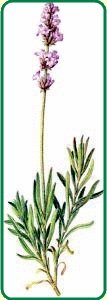Stress Relief Benefits of Lavender

The stress relief benefits of lavender are dependable and invaluable in today's hectic world.
Lavender flower is calming and relaxing both physically and emotionally.
- Lavender is particularly useful for easing tension headaches, and other physical aches and pains.
- It is very useful for easing the digestive upsets and gas which often accompany stress.
- It has been used to ease depression.
- Lavender is said to be very helpful for people who are “stuck” in repetitive patterns of thinking about a particularly stressful or traumatic event or circumstance in their lives.
- It is also often used for encouraging deep restful
sleep and stress relief. - Lavender soothes the respiratory system, making
breathing for stress relief easier.
How to Use Lavender
Making lavender herbal tea - some herbalists suggest taking ½ to 1 teaspoon of the dried flowers per serving. Place the lavender flowers in a cup, pouring boiling water over the herb. Then cover the cup and letting the tea steep for 10 to 15 minutes before drinking. This can be done a couple of times a day and is generally considered quite safe. (It is suggested to avoid using large amounts of lavender during pregnancy.)
Lavender is often used in the form of an essential oil. It is sometimes considered to be an almost universal remedy which helps bring the body and mind to a state of balance.
Getting the benefits of lavender is easy with lavender essential oil
Lavender has a mild pleasant aroma. The benefits of lavender oil are similar to those of the herb. But the process of using the oil is different. Since essential oils are generally purchased in small bottles, they are very portable and convenient.
There are many varied uses for lavender essential oil.
- With lavender essential oil one might place a few drops on the pillow case at night to promote restful sleep.
- I sometimes apply a few drops of lavender oil to on my temples or some other part of my head to ease a tension headache or eyestrain. (Please keep the oil away from the eyes.)
- The oil is well known as helpful burn remedy. It can be applied directly to the skin.
- Lavender essential oil can also be applied directly to aching or painful muscles or joints.
- The benefits of lavender oil include relaxation from overwork, one of the main causes of stress. Try rubbing a few drops of the oil between the palms of your hands and then bringing your palms to your face and breathing deeply of the scent. It can bring soothing relief.
- Even adding a few drops of lavender essential oil to the washing machine can also add a soothing fresh aroma to the laundry room and clothes and help make routine housework more enjoyable. It's another example of the diverse benefits of lavender.
How Does Lavender Work?
The healing soothing benefits of lavender are generally thought to derive from specific physical constituents including: flavonoids, coumarins, triterpenes and of course volatile oils for which lavender is famous.
Safety
Lavender is generally considered safe and gentle. Lavender has been used by herbalists for hundreds of years.
Lavender Plant Care - Growing Tips
Lavender is a common plant. It is easy to relatively grow and is therefore relatively inexpensive. Since lavender grows easily, you might wish to grow some of your own. It is a lovely addition to any garden and can even be grown successfully in large pots on an apartment balcony or patio.
Since it is a perennial in temperate zone locations, you can plant it once and with proper care it will give you five to seven years of blossoms which return effortlessly every summer. (If you live in a harsher climate, check local garden books for more specific instructions.)
For optimum lavender plant care use soil which is well drained yet retains some moisture. Place the plants in a sunny location. It is best to cut back the plants after the flowers are harvested. This pruning can also be done in the early spring before new growth begins.
You can read about other herbs which are particularly useful for
herbal stress relief, or
Read about other essential oils used for aromatherapy stress relief, or
Explore additional stress relief tips by visiting Gentle Stress Relief home page.
Please remember, this page is informational. It is not intended to be medical advice. It is always wise to consult with a trained health care professional for appropriate recommendations for your situation.
Sources:
Hoffmann, David. 1987, 1988, 1998. The Herbal Handbook A User’s Guide to Medical Herbalism. Rochester Vermont: Healing Arts Press
Hoffmann, David. 2003. Medical Herbalism The Science and Practice of Herbal Medicine. Rochester Vermont: Healing Arts Press
Higley, Connie and Alan. 1998. Reference Guide for Essential Oils. Olathe, KS: Abundant Health
Winston, David and Maimes, Steven. 2007. Adaptogens Herbs for Strength, Stamina, and Stress Relief. Rochester, Vermont: Healing Arts Press